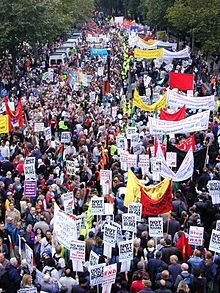On February 15, 2003, the world witnessed an unprecedented display of global solidarity and activism as millions of people took to the streets in over 600 cities to protest against the impending war in Iraq. This historic event, known as the largest peace demonstration in history, united individuals from diverse cultures and nations in a powerful message of opposition to military action.
The protest was a response to the escalating tensions between the United States and Iraq, with the U.S. government under President George W. Bush advocating for military intervention to remove Saddam Hussein from power. However, this decision was met with widespread opposition and skepticism from the international community.
The peace demonstration on February 15, 2003, marked a turning point in public opinion regarding the war in Iraq. It showcased the power of grassroots activism and the ability of ordinary citizens to come together to voice their concerns and stand up for peace. The sheer scale of the protests sent a clear message to world leaders that the public was not in favor of military intervention.
Cities around the world saw an outpouring of support for the peace movement. In London, an estimated two million people marched through the streets, making it the largest protest in British history. Similarly, in Rome, over one million people gathered in what was described as a sea of banners and placards calling for peace. Other major cities such as New York, Sydney, Paris, Berlin, and Tokyo also witnessed massive turnouts.
The global nature of the demonstrations highlighted the interconnectedness of people’s concerns about the war in Iraq. It was not just a localized issue; it was a matter of global importance. The protests brought together individuals from all walks of life, transcending borders and cultures, to unite under a common cause for peace.
The significance of the largest peace demonstration in history cannot be overstated. It demonstrated the power of public opinion and the impact it can have on shaping international affairs. Despite the overwhelming opposition to the war, the U.S. and its allies proceeded with military action in Iraq the following month. However, the event served as a reminder that the voice of the people should not be ignored and that peaceful alternatives should always be explored before resorting to armed conflict.
The legacy of the 2003 peace demonstration lives on in the collective memory of those who participated and witnessed the historic event. It serves as a reminder of the importance of activism and the potential for change when individuals come together for a common cause. The event also sparked renewed interest in the anti-war movement and inspired many to continue advocating for peace in subsequent years.
In conclusion, the largest peace demonstration in history, which took place on February 15, 2003, was a momentous event that brought millions of people from around the world together in a powerful display of opposition to the impending war in Iraq. Despite the war proceeding the following month, the protest remains a symbol of global solidarity and the enduring power of public opinion. It serves as a reminder that the pursuit of peace should always be prioritized and that individuals have the ability to make their voices heard on matters of international importance.
SEO Excerpt: On February 15, 2003, the largest peace demonstration in history took place, with millions of people around the world protesting against the impending war in Iraq. This historic event showcased the power of grassroots activism and the impact of public opinion on international affairs. Despite the war proceeding, the protest remains a significant moment of global solidarity and activism.

